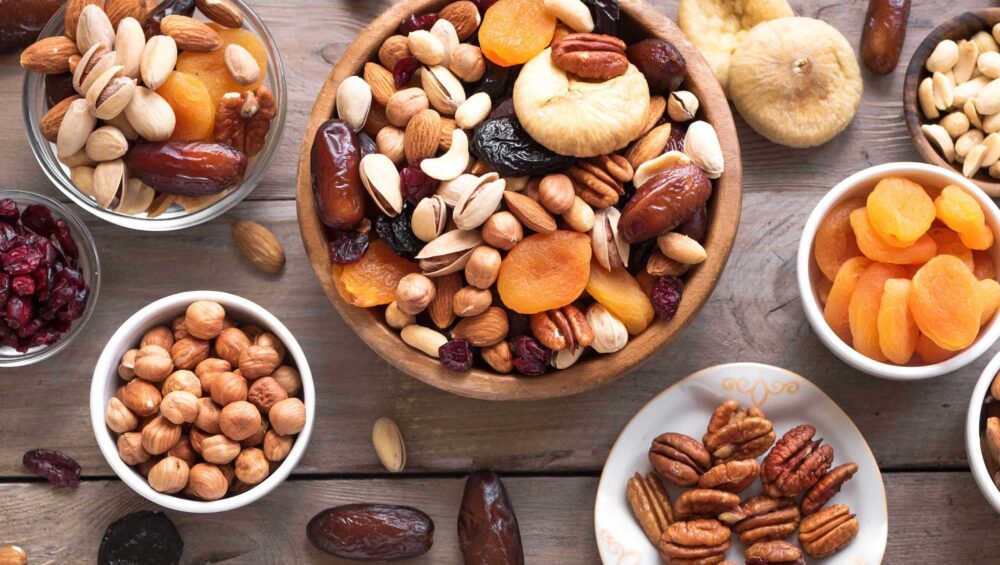The northern areas of Pakistan, known for their stunning landscapes and rich cultural heritage, are also home to some of the most delicious and nutritious dry fruits in the world. The unique climate and fertile soil of regions like Gilgit-Baltistan, Hunza, and Skardu create ideal conditions for cultivating a variety of fruits, which are then sun-dried to enhance their flavors and preserve their nutritional value. In this blog, we’ll explore the seasonal dry fruits of these breathtaking mountains and valleys, highlighting their availability throughout the year.
1. Winter Delights: Walnuts and Dried Figs
Walnuts
- Harvest Season: October to December
- Benefits: Rich in omega-3 fatty acids, walnuts are known for their heart-healthy properties. They are also high in antioxidants and can improve brain function.
- Uses: Snack on them raw, add to salads, or incorporate them into baked goods for added crunch and nutrition.
Dried Figs
- Harvest Season: Late autumn (October)
- Benefits: Dried figs are a great source of dietary fiber, calcium, and potassium, promoting digestive health and bone strength.
- Uses: Enjoy dried figs as a snack, add them to smoothies, or use them in desserts.
2. Spring Bounty: Dried Apricots and Almonds
Dried Apricots
- Harvest Season: April to June
- Benefits: Packed with vitamins A and C, potassium, and antioxidants, dried apricots help boost immunity and improve skin health.
- Uses: Use dried apricots in salads, oatmeal, or enjoy them as a healthy snack.
Almonds
- Harvest Season: March to May
- Benefits: Almonds are high in healthy fats, protein, and vitamin E, promoting heart health and aiding in weight management.
- Uses: Snack on raw almonds, use them in trail mixes, or blend them into almond milk.
3. Summer Treasures: Dried Mulberries and Raisins
Dried Mulberries
- Harvest Season: June to July
- Benefits: Mulberries are rich in iron, vitamin C, and antioxidants, supporting healthy blood and immune function.
- Uses: Add dried mulberries to cereals, yogurt, or baked goods for a burst of sweetness.
Raisins
- Harvest Season: July to August
- Benefits: Raisins provide quick energy, are high in iron and potassium, and may help regulate blood pressure.
- Uses: Use raisins in baking, salads, or as a sweet addition to trail mixes.
4. Autumn Harvest: Dried Apricots and Prunes
Dried Apricots (Second Harvest)
- Harvest Season: August to September
- Benefits: The second harvest of dried apricots offers the same benefits as spring, with added sweetness as they mature.
- Uses: Perfect for making jams, chutneys, or simply enjoying as a snack.
Dried Prunes
- Harvest Season: September to October
- Benefits: Dried prunes are famous for their digestive benefits and are rich in vitamins and minerals like vitamin K and potassium.
- Uses: Snack on them directly, or use them in baked goods and smoothies for natural sweetness.
5. Year-Round Treasures: Dried Fruits
Some dry fruits are available throughout the year due to their extensive harvest seasons and processing methods.
- Pine Nuts: Harvested in late summer, pine nuts are a great source of healthy fats and protein. They can be added to salads or used in pesto.
- Dried Dates: Known for their natural sweetness, dried dates are available year-round and are rich in fiber and minerals. Enjoy them as a snack or in energy bars.
Conclusion
The seasonal dry fruits of northern Pakistan are not only a treat for the palate but also provide numerous health benefits. From walnuts in the winter to apricots and almonds in spring, these fruits offer a variety of flavors and nutrients that can enhance your diet year-round.
By incorporating these nutritious dry fruits into your meals, you can enjoy their health benefits while supporting local farmers and promoting sustainable agriculture in the region. So, the next time you savor the delightful taste of northern Pakistan’s dry fruits, remember that you are indulging in a rich tradition that nourishes both the body and the land.

